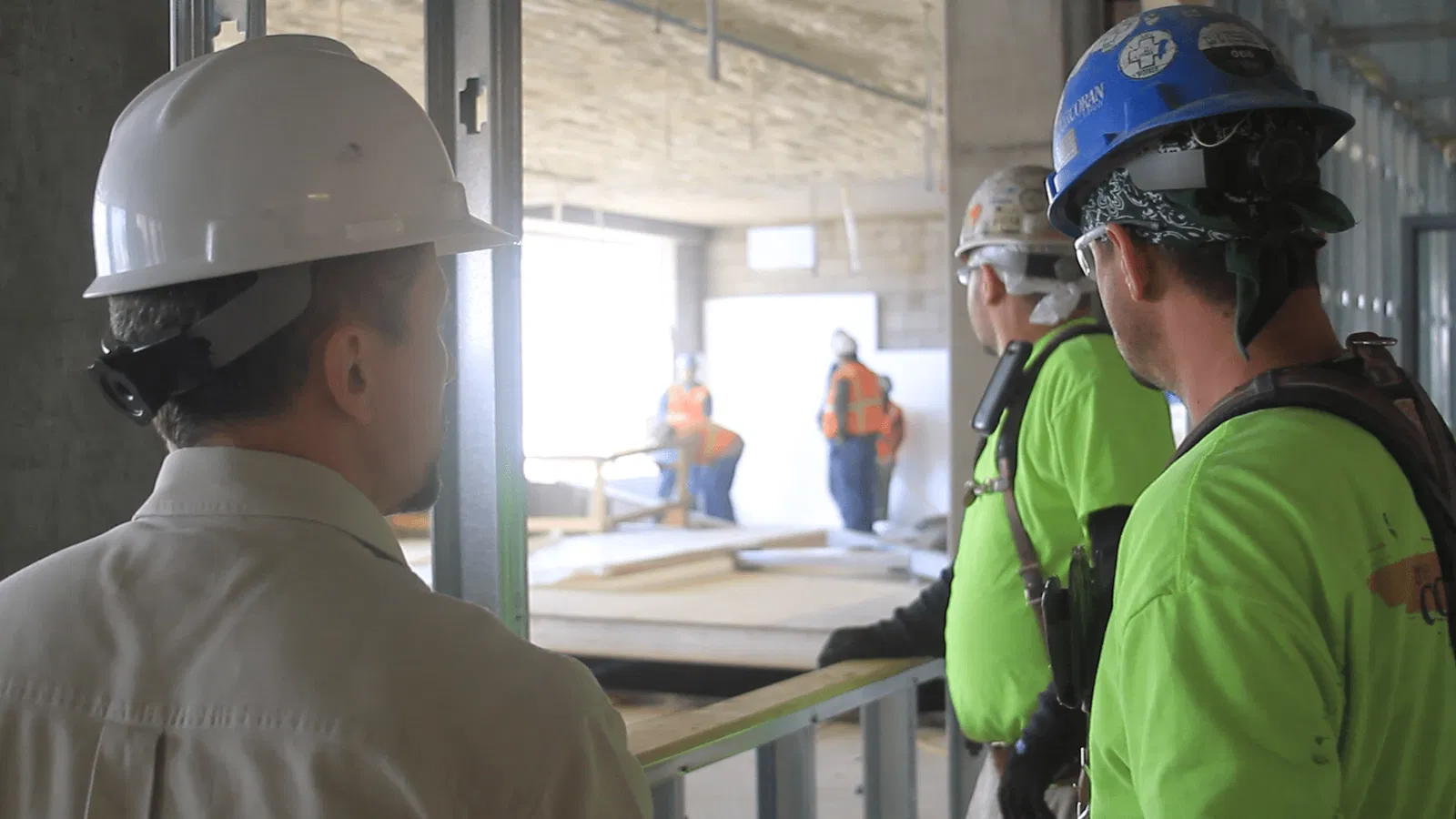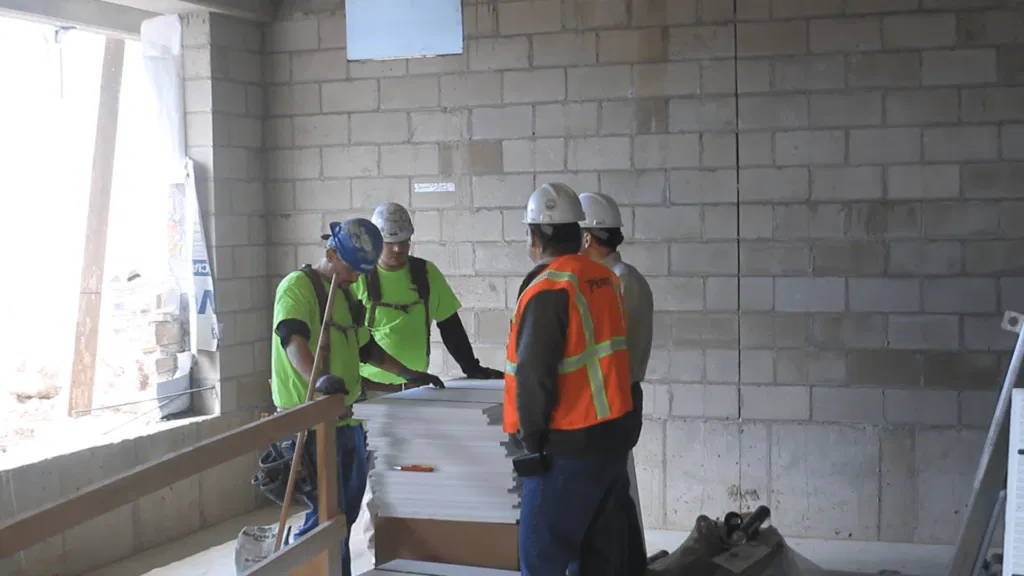

Interview with Professional Contractors about InSoFast

| Install Guide | Ordering Guide | Contact/Quote |
Construction is an interconnected industry. Architects, contractors, electricians, plumbers, and building code inspectors are all responsible for working together to create a successful finalized project. We recently spoke with Brian Conn, the Project Manager and Cost Estimator for The Corcoran Company, a Colorado based leader in commercial drywall contracting.
Brian was part of the team that worked with InSoFast EX 2.5 panels on Colorado State University’s Moby Arena. Brian discusses the project and how he managed introducing a new product into the workplace. He also fills us in on the environmentally conscious city of Fort Collins and how he decided to donate extra InSoFast panels to a non-profit reuse center.
Can you tell us a little about your background and how long you’ve been working as the Project Manager for The Corcoran Company?
I’ve worked as a Project Manager and Cost Estimator at The Corcoran Company for 23 years. We do strictly commercial work including institutional work at universities, medical work, and light industrial work and office buildings projects. I actually started working for a different commercial drywall contractor part time while I was still in college at Colorado State University. I started my college career in natural resources in forestry and forest fire science, but always had an interest in construction. I ended up switching majors to move towards working in the construction industry, so I’ve been in the industry for over 25 years.
You recently managed the construction of an 8,000 sq ft state-of-the-art training facility at Colorado State University’s Moby Arena. Architect Mick Aller chose to work with InSoFast EX panels on the project. Can you tell us about your experience using InSoFast EX for the Moby Arena?
We actually started working last summer on some small additions to the Moby Arena so we already had a relationship going with the general contractor and the architect. The general contractor was doing some costs and projections and was approached by Mick Aller to look into InSoFast as an alternative to the traditional framed z-furring system.
He asked me to take look at the product, give an opinion and come up with some rough cost estimates. I spent a couple of hours going through your website and watched some of the videos. I was excited about using InSoFast, because it seemed like a great fit for the project.

As a sub-contractor The Corcoran Company is known for beating the schedule, working fast and keeping large and complicated project on time and under budget. What crosses your mind when a new product like InSoFast EX appears on a plan and specification?
We are always looking at new products as things develop and change. From our side of things in the office we are probably more willing to try new things than the guys in the field, but we can all face some reluctance and skepticism.

One of my concerns in this type of construction even with a z-furring system is that when you’re attaching something directly to a concrete wall or masonry wall it can have imperfections. I needed to know what kind of abilities we would have to work with the material to get it straight and plum. This can be a real challenge sometimes if the masonry is not installed just right.
In the construction industry, project managers like yourself are already swamped with responsibilities coordinating with your jobsite foreman and in the field installers. Did introducing a new product like InSoFast EX affect the project schedule?
From a scheduling standpoint we were able to get the panels installed fairly quickly and it went very smoothly. We also arranged ahead of time for Dean to come out to Fort Collins on the first day of installation to get my guys going down the right road with installing the product. I’m sure we could have figured out the installation without him, but it’s always helpful to learn the best way to do even the simple things. We definitely got some great tips and techniques from Dean that aided in the installation process.

Your company is well known for your expertise, and coordination with the electricians, plumbers, painters and other specialty contractors who follow your work. How did InSoFast interface with them and what were the challenges you faced in coordinating with them?
Before we even started the project I had a sample pack sent to the office and had a few of the guys physically look at it and give me their thoughts. We actually even took it out to the job and had the electricians look at the panel so that they knew what was coming. This was a huge help because until they had a chance to look at the sample pack they were a bit apprehensive about whether or not they would be able to get their product installed properly.
Installing traditional Z-furring and insulation is a time consuming part of the building process. How did using InSoFast change this aspect of the project?
It was certainly much quicker and easier to install this product than traditional metal framing. I think InSoFast is a superior product versus metal stud or furring type of installation, not only in terms of the thermal aspect of the material, but also from the design side of things.

There are new energy codes that have been implemented in the industry over the last several years, especially in regards to the exterior wall. It’s been a lot more focused on thermal and moisture protection and I know InSoFast virtually eliminates the idea of thermal conductivity through the studs.

In more traditional methods like z-furring the material transfers the cold from the outside of the building to the inside of the building. The advantages of using InSoFast whether for residential, or commercial settings are very clear.
When the project was complete you were left with about 40 extra panels. InSoFast panels are engineered to eliminate waste, but it’s pretty standard practice in commercial construction to over order by about 10%. Can you talk to us about the environmental issues you face as a sub-contractor in terms of waste material?
In the entire industry over the last several years there has been an exponential move towards sustainability and green building. The whole system of LEED projects has really taken off over the last 5 years. I remember 20 years ago there was talk of green building and sustainability- it was around but it wasn’t in the mainstream of the construction industry.
Our community here in Fort Collins is very into environmental thinking. The city itself has rebate programs to promote the idea of sustainability. For example, this year I got rid of my gas mower and bought the old style push mower. The city will essentially pay people to do things like this with rebate programs. Waste is also a big concern and recycling has been pushed for many years but there’s always a push towards better recycling and trying to keep things out of the landfill.

It’s never a green or earth-friendly option to ship a product back or send it to the landfill. You contacted us with hopes of finding a way to reuse the panels and together we decided that donating them to a local charity like Habitat for Humanity would be a fantastic solution. Have you decided where the panels will be donated? Does this idea of local reuse change your idea of how you will deal with building waste material in the future?
Locally we have a Habitat for Humanity Store, but there is also another non-profit called ReSource. They resell building materials donated by contractors and the general public. ReSource is pretty much strictly building materials and it’s where I’ve decided to donate the extra panels.
There’s also a non-profit in Fort Collins that focuses primarily on teaching people about construction by deconstructing buildings. They take apart buildings piece by piece and reuse as much of the materials as possible, rather than dumping them in the landfill. I’ve seen them work with older buildings that were built back when a 2 x 4 actually measured 2 x 4 inches. Now 2 x 4s are getting thinner and the money is made by shaving off 1/16 inch and the product is still called a 2 x 4. Materials from old buildings are now pretty highly coveted when you can actually find them.
Recycling waste during construction is also pretty common in Fort Collins and is definitely something we are always thinking about. We work on many projects where there will be 4 or 5 different dumpsters that are designated for either recyclable steel, wood, and even cardboard. This doesn’t even just happen for LEED projects, but also on projects where the manager keeps LEED in mind without actually going for the certification. We didn’t want to throw away these usable panels, which is why we are donating them to Resource.
We’re pleased to hear you had such a great experience using InSoFast. Would you consider using our product again in the future?
We often have the chance to talk with architects that ask for the opinion of the contractors and the people who are installing the product. It’s certainly something I would recommend and tell them to look into as a possible alternative to more traditional methods. My lead man on the site was also really pleased and would not hesitate at all to use InSoFast for a future project.

Organizations like ReSource are scattered all over the country and we encourage you to check out your local reuse center. You may find just the material you need for that summer DIY project, or perhaps the perfect place to donate extra materials from your recent basement renovation.
When ordering InSoFast, we like to stress a “Goldilocks Rationale” – not too much, not too little, just right. However, we understand complex scenarios abound and if you are interested in donating extra InSoFast panels locally, please contact us first to learn how you can receive donation credits! Important: prior authorization is necessary to receive the credit.
Special Thanks to Brian Conn and the Corcoran Company, all those involved with the Moby Arena Project, and ReSource of Ft. Collins, CO.

